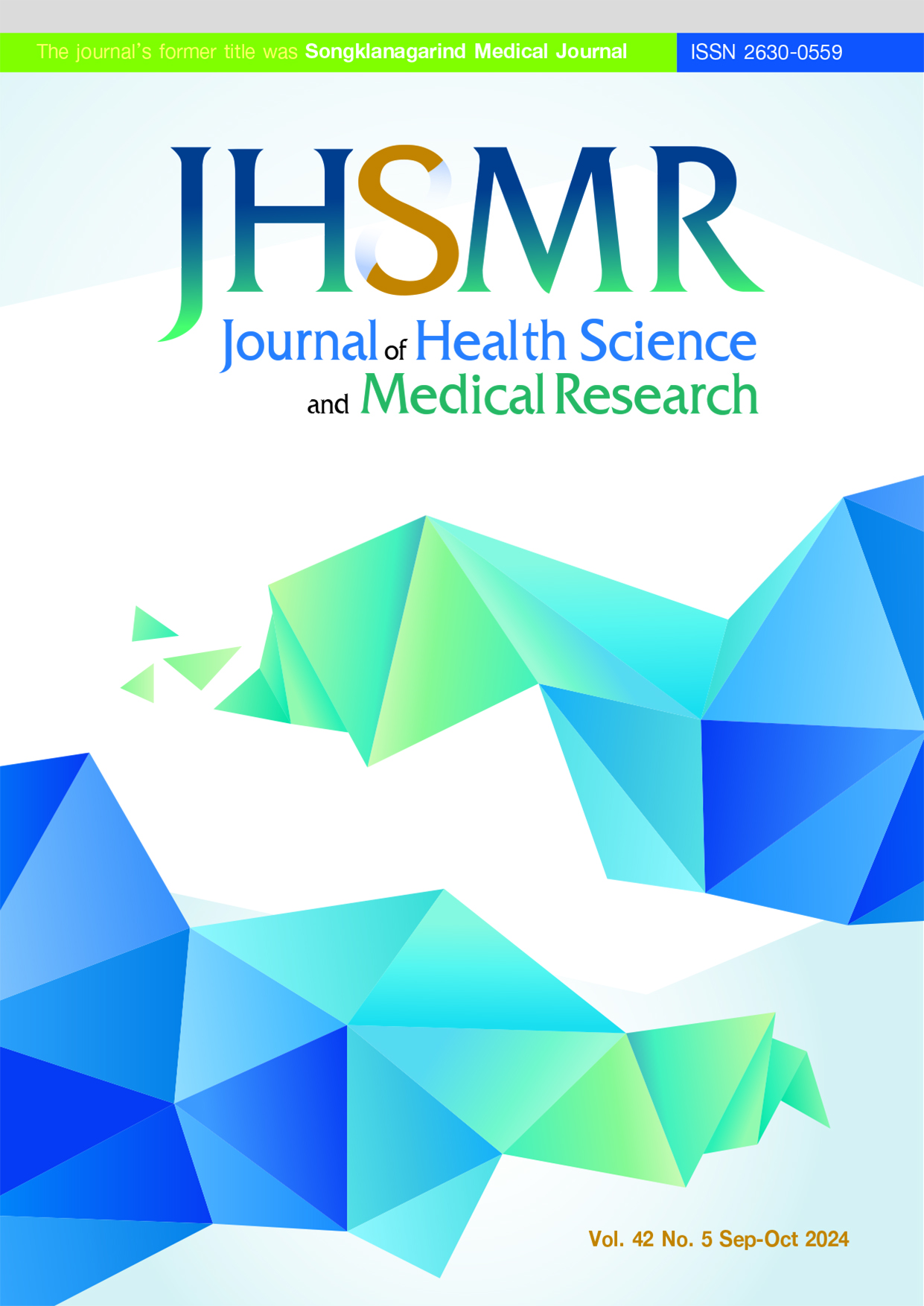The Cross-Cultural Adaptation and Psychometric Properties of the Exercise Benefits and Barriers Scale Following Translation into the Telugu Language for Use in Type 2 Diabetes Patients
DOI:
https://doi.org/10.31584/jhsmr.20241059Keywords:
cross-cultural adaptation, EBBS, psychometric properties, Telugu language, type 2 DiabetesAbstract
Objective: Although it is well known that exercise has many benefits, many people encounter barriers to following a regular fitness regime. The Exercise Benefits and Barriers Scale (EBBS) had been developed in the English language to understand the perceptions of people about the benefits and barriers of exercise participation. The main intent of the current study was to translate the EBBS into the Telugu language and assess the psychometric properties of cross-culturally adapting the scale in people with Type 2 diabetes in Telangana State of India.
Material and Methods: According to the translation guidelines, forward and backward translation was carried out and the final Telugu version of the questionnaire was prepared and distributed. A total of 103 responses were received from Type 2 diabetes patients in Telugu-speaking states of India from March 2022 to June 2022. Reliability and validity were assessed using Intra class Correlation Coefficient and Cronbach’s alpha was calculated to evaluate the internal consistency.
Results: The reliability of the complete EBBS and its subscales were significantly high, with Cronbach’s alpha of more than 0.7 (0.946 for the Exercise Benefits subscale and 0.879 for the Exercise Barriers subscale) for all items in the Telugu version showing good internal consistency.
Conclusion: The results of the translated and cross-culturally adapted Telugu version of EBBS demonstrated satisfactory reliability and validity in a Type 2 Diabetes population, and therefore can be used in the Telugu-speaking population.
References
Yang JJ, Yu D, Wen W, Saito E, Rahman S, Shu XO, et al. Association of diabetes with all-cause and cause-specific mortality in Asia: a pooled analysis of more than 1 million participants. JAMA Netw Open 2019;2:e192696.
Chawla A, Chawla R, Jaggi S. Microvasular and macrovascular complications in diabetes mellitus: distinct or continuum? Indian J Endocrinol Metab 2016;20:546-51. doi: 10.4103/2230-8210.183480.
Sun H, Saeedi P, Karuranga S, Pinkepank M, Ogurtsova K, Duncan BB, et al. IDF Diabetes Atlas: Global, regional and country-level diabetes prevalence estimates for 2021 and projections for 2045. Diabetes Res Clin Pract 2022;183:109119. doi: 10.1016/j.diabres.2021.109119.
Aune D, Norat T, Leitzmann M, Tonstad S, Vatten LJ. Physical activity and the risk of type 2 diabetes: a systematic review and dose-response meta-analysis. Eur J Epidemiol 2015;30:529–42.
Davies MJ, D’Alessio DA, Fradkin J, Kernan WN, Mathieu C, Mingrone G, et al. Management of hyperglycemia in type 2 diabetes, 2018. A consensus report by the American Diabetes Association (ADA) and the european association for the study of diabetes (EASD). Diabetes Care 2018;41:2669–701.
Snowling NJ, Hopkins WG. Effects of different modes of exercise training on glucose control and risk factors for complications in type 2 diabetic patients: a meta-analysis. Diabetes Care 2006;29:2518–27.
Sloan G, Shillo P, Selvarajah D, Wu J, Wilkinson ID, Tracey I, et al. A new look at painful diabetic neuropathy. Diabetes Res Clin Pract 2018;144:177-91.
LeMaster JW, Mueller MJ, Reiber GE, Mehr DR, Madsen RW, Conn VS. Effect of weight-bearing activity on foot ulcer incidence in people with diabetic peripheral neuropathy: Feet first randomized controlled trial. Phys Ther 2008;88:1385–98.
Beauford JE, Nagashima Y, Wu MH. Using Translated Instruments In Research. J Coll Teach Learn 2011;6:77–82.
Akbari Kamrani AA, Zamani Sani SH, Fathire-Zaie Z, Bashiri M, Ahmadi E. The psychometric characteristics of the exercise benefits/barriers scale among Iranian elderly. Iran J Public Health 2014;43:362–6.
Amiri Farahani L, Parvizy S, Mohammadi E, Asadi-Lari M, Kazemnejad A, Hasanpoor-Azgahdy SB, et al. The psychometric properties of exercise benefits/barriers scale among women. Electron Physician 2017;9:4780–5.
Enríquez-Reyna MC, Cruz-Castruita RM, Ceballos-Gurrola O, García-Cadena CH, Hernández-Cortés PL, Guevara-Valtier MC. Psychometric properties of the Exercise Benefits/Barriers scale in Mexican elderly women. Rev Lat Am Enfermagem 2017;25:e2902.
Colberg SR, Sigal RJ, Fernhall B, Regensteiner JG, Blissmer BJ, Rubin RR, et al. Exercise and type 2 diabetes: The American College of Sports Medicine and the American Diabetes Association: joint position statement. Diabetes Care 2010;33.
Beaton DE, Bombardier C, Guillemin F, Ferraz MB. Guidelines for the process of cross-cultural adaptation of self-report measures. Spine 2000;25:3186-91.
Maydeu-Olivares A, Shi D, Rosseel Y. Assessing Fit in Structural Equation Models: A Monte-Carlo Evaluation of RMSEA Versus SRMR Confidence Intervals and Tests of Close Fit. Struct Equ Model 2018;25:389–402. doi: 10.1080/10705511.2017.1389611.
Shi D, Maydeu-Olivares A, Rosseel Y. Assessing fit in ordinal factor analysis models: SRMR vs. RMSEA. Struct Equ Model 2020;27:1–15. doi: 10.1080/10705511.2019.1611434.
Gagnier JJ, Lai J, Mokkink LB, Terwee CB. COSMIN reporting guideline for studies on measurement properties of patient-reported outcome measures. Qual Life Res 2021;30:2197–218. doi: 10.1007/s11136-021-02822-4.
Gupta S, Bansal S. Does a rise in BMI cause an increased risk of diabetes?: evidence from India. PLoS One 2020;15:e0229716.
Sechrist KR, Walker SN, Pender NJ. Development and psychometric evaluation of the exercise benefits/barriers scale. Res Nurs Health 1987;10:357–65.
Victor JF, Ximenes LB, Almeida PC de. Reliability and validity of the exercise benefits/barriers scale in the elderly. Acta Paul Enferm 2012;25:48–53.
Abdullah MF, Nazarudin MN, Saadan R, Wan WA, Pa MR. Benefits and barriers of physical activities among technical university students. J Adv Res Soc Sci 2018;13:1-8.
Lovell GP, Ansari W El, Parker JK. Perceived exercise benefits and barriers of non-exercising female university students in the United Kingdom. Int J Environ Res Public Health 2010;7:784–98.
Kadariya S, Aro AR. Barriers and facilitators to physical activity among urban residents with diabetes in Nepal. PLoS One 2018;13:1–21.
Thomson RL, Buckley JD, Brinkworth GD. Perceived exercise barriers are reduced and benefits are improved with lifestyle modification in overweight and obese women with polycystic ovary syndrome: A randomised controlled trial. BMC Womens Health 2016;16:14. doi: 10.1186/s12905-016-0292-8.
Downloads
Published
How to Cite
Issue
Section
License

This work is licensed under a Creative Commons Attribution-NonCommercial-NoDerivatives 4.0 International License.
























